Waterloo County, Ontario
Waterloo County, created in 1853 and dissolved in 1973, was the forerunner of the Regional Municipality of Waterloo in Ontario, Canada. Situated on a subset of land within the Haldimand Tract, the traditional territory of the Attawandaron, Anishinaabe and Haudenosaunee peoples, Waterloo County consisted of five townships: Woolwich, Wellesley, Wilmot, Waterloo, and North Dumfries. The major population centres were Waterloo, Kitchener (known as Berlin prior to 1916), Preston, Hespeler, Blair, and Doon in Waterloo township; Galt in North Dumfries; Elmira in Woolwich; and New Hamburg in Wilmot. All are now part of the Regional Municipality.
Waterloo County | |
|---|---|
Former County | |
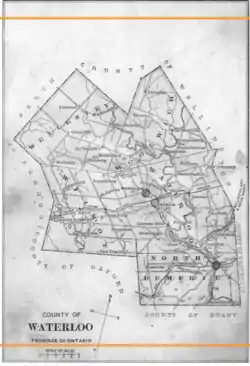 | |
| Established | 1853 |
| Dissolved | 1973 |
| Time zone | Eastern (EST) |
History
Waterloo County was once one of the most densely wooded sections in North America. Oak trees three to four feet in diameter, maple, beech, elm, ash oak and great pines were common. The county, located in the northerly edge of Attawandaron land, was excellent for hunting and fishing.
In 1784, by way of the Haldimand Proclamation, the British Government granted the Grand River valley to Iroquois confederation refugees from central and western New York State, Indigenous peoples who served as allies during the American Revolution.[1] The area was from Lake Erie to the Elora falls, and the width being six miles on each side of the river. The First Nations soon offered almost half of the upper area for sale. It was divided into four blocks. Blocks 1, 2 and 3 were sold by 1816; this large area became the townships of Waterloo, Woolwich and Dumfries.[2]
The western part of this area was initially settled by Mennonites of German extraction from Pennsylvania; most settled the area that would become Kitchener, St. Jacobs, Elmira and surroundings. The southern part (now Cambridge) – as well as areas that would become Fergus and Elora, just outside Waterloo County – were settled by Scots. Except for grist, woolen and saw mills, there was little industry in any of these area until about 1870.[2]
1800 to 1819
Settlement of the what became the Township of Waterloo started in 1800 by Joseph Schoerg and Samuel Betzner, Jr. (brothers-in-law), Mennonites, from Franklin County, Pennsylvania. Other settlers followed mostly from Pennsylvania typically by Conestoga wagons. The early group purchased land from Richard Beasley who had acquired it from the Six Nations. The first school was begun in 1802 near the village of Blair. The first teacher's name was Rittenhaus of Pennsylvania.
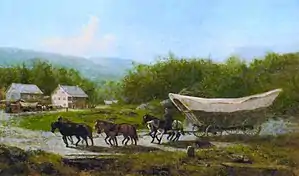
Many of the pioneers arriving from Pennsylvania after November 1803 bought land in a 60,000-acre section of Block Two from the German Company established by a group of Mennonites from Lancaster County Pennsylvania. The Tract included most of Block 2 of the previous Grand River Indian Lands.[1] Many of the first farms were least four hundred acres in size.[3][4] The German Company, represented by Daniel Erb and Samuel Bricker, had acquired the land from previous owner Richard Beasley; he had gotten into financial difficulties after buying the land in 1796 from Joseph Brant who represented the Six Nations. The payment to Beasly, in cash, arrived from Pennsylvania in kegs, carried in a wagon surrounded by armed guards.[5]
The majority of the settlers of the Lower Block along the Grand River (including areas such as the current Freeport and Hespeler) were also Mennonites from Pennsylvania often called Pennsylvania Dutch although they were actually Deutsch or Deitsch, German. Others immigrated from the British Isles and directly from Germany, producing a mix of cultures.[6]
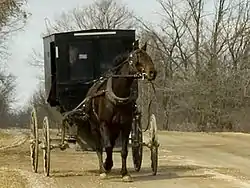
Later declared the founder of the city of Waterloo, Abraham Erb, a German Mennonite from Lancaster County, Pennsylvania, bought 900 acres of bush land in 1806 from the German Company; (this would later be part of Waterloo Township). He built a sawmill in 1808 and a gristmill in 1816; the latter operated continuously for 111 years.[7] Other early settlers of what would become Waterloo included Samuel and Elia Schneider who arrived in 1816. Until about 1820, settlements such as this were quite small.[3]
By 1804, the cemetery in the village of Blair (now part of Cambridge) was already in use. The next cemetery to be started is the one next to Pioneer Tower in Doon; the first recorded burial at that location was in 1806. The cemetery at First Mennonite church at 800 King St. East in Kitchener is not as old, but contains the graves of some notable citizens, including Bishop Benjamin Eby who died in 1853, Joseph Schneider, and Rev. Joseph Cramer, founder of the House of Friendship social service agency.[8]
In 1807, 45,195 acres (182.9 km2) of Block 3 (Woolwich) was purchased by Pennsylvanians John Erb, Jacob Erb and others.
Later named the founder of Kitchener, Benjamin Eby (made Mennonite preacher 1809, and bishop in 1812) arrived from Lancaster County, Pennsylvania in 1806 and purchased a very large tract of land consisting of much of what would become the village of Berlin (named about 1830). The settlement was initially called Ebytown and was at the south-east side of what would later become Queen Street. (Eby was also responsible for the growth of the Mennonite church in Waterloo County; he built the first church in 1813.) Abram Weber settled on the corner of what would become King and Wilmot Streets and David Weber in the area of the much later Grand Trunk Railway station.[3][7] Benjamin Eby encouraged manufacturers to move to the village. Jacob Hoffman came in 1829 or 1830 and started the first furniture factory.
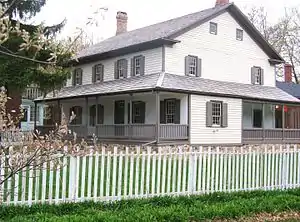
Almost as important as Benjamin Eby in the history of Kitchener, Joseph Schneider of Lancaster County, Pennsylvania (son of immigrants from southern Germany) bought lot 17 of the German Company Tract of block 2 in 1806. While farming, he helped to build what became "Schneider's Road" and by 1816 built a sawmill. Years later, Schneider and Phineas Varnum would help form the commercial centre of Ebytown.[9]
The War of 1812 interrupted settlement. The Mennonite settlers refused to carry arms so were employed in non-combatant roles in camps and hospital and as teamsters in transport service during the war.[10]
William Dickson of Niagara purchased land in the township of North Dumfries and South Dumfries. With his land agent, Absolom Shade, he located a town site on the Grand River. Settlers were attracted, largely from Scotland with the price of land being about four dollars an acre. Years later (1827), this village would be named Galt for John Galt, the British author and then Superintendent of the Canada Company headquartered in Guelph. Galt was a friend of William Dickson.
1819 to 1852
John Eby, druggist and chemist, arrived from Pennsylvania in about 1820 and opened a shop to the west of what would later be Eby Street. At the time, it was common for settlers to form a building "bee" to help newcomers erect a long home.[3] Immigration from Lancaster county continued heavily in the 1820s because of a severe agricultural depression in Lancaster County.[6] Joseph Schneider also settled in that area and built a frame house in 1820 on the south side of the future Queen Street after clearing a farm and creating a rough road. A small settlement formed around "Schneider's Road" which later became the nucleus of Berlin. The home was renovated over a century later and still stands.[7]
The village centre of what would become Berlin (and later, Kitchener) was established in 1830 by Phineas Varnum who leased land from Joseph Schneider and opened a blacksmith shop on the site where a hotel would be built many years later, the Walper House. A tavern was also established here at the same time and a store was opened.[3] At the time, the settlement of Berlin was still considered to be a hamlet.[4]
By 1830 the village of Preston was a thriving business centre with Jacob Hespeler, a native of Württemberg and a prominent citizen. He would later move to the village of New Hope that was renamed Hespeler in 1857 in recognition of his public service and the industries he started there. Jacob Beck from the Grand Duchy of Baden founded the village of Baden in Wilmot Township and started a foundry and machine shop. Jacob Beck was the father of Sir Adam Beck.
The first newspaper of the county (first issue dated August 27, 1835) was the Canada Museum und Allgemeine Zeitung, printed mostly in German and partly in English. It was published for only five years.[11]
The land which now makes up the township of Woolwich, Ontario, including communities such as St. Jacobs, Ontario and Elmira, Ontario, were first settled in the early 1800s.[12] The early settlers were primarily from England or Ireland but after 1830, Mennonites from Pennsylvania formed a significant proportion of the population.[13][14][15][16] The area still retains much of its traditional character. Old Order Mennonites can still be seen on the local roads using their traditional horse and buggy transportation.[17][18][19]
By 1835, many immigrants to Waterloo County were not from Pennsylvania. Many settler came from England, Ireland, Scotland and Germany to areas such as New Germany in the Lower Block of Block Two. In 1835, approximately 70% of the population was Mennonite but by 1851, only 26% of the much larger population were of this religion.[6] This was due to the large wave of new German migrants from Europe, particularly between 1830 and 1850.[20][21]
The Wellington District and Waterloo County were formed in June 1840[22] from territory transferred from certain other districts:
| District | County | Townships | Other lands |
|---|---|---|---|
| Gore | Halton |
|
|
| Home | Simcoe |
|
|
| London | – |
- later surveyed to form the townships of Wellesley and Peel
- later surveyed to form the townships of Maryborough and Wallace
- being the Mississaugas
- acquired under the Saugeen Tract Agreement
- the sum of which was surveyed into townships on either side of the Garafraxa Road that was constructed in the period 1840-1848 to the new community of Sydenham
The district town was Guelph.[24]
Records indicate a population of 13,782 in 1841. The Smith's Canadian Gazetteer of 1846 states that the Township of Waterloo (smaller than Waterloo County) consisted primarily of Pennsylvanian Mennonites and immigrants directly from Germany who had brought money with them. At the time, many did not speak English. There were eight grist and twenty saw mills in the township. In 1841, the population count was 4424. In 1846 the village of Waterloo had a population of 200, "mostly Germans". There was a grist mill and a sawmill and some tradesmen.[25] Berlin (Kitchener) had a population of about 400, also "mostly German", and more tradesmen than the village of Waterloo."[26]
Reorganization of the County (1852-1853)
At the beginning of 1852, the County was divided into three, forming the United Counties of Wellington, Waterloo and Grey:[27]
| New County | Territory |
|---|---|
| Wellington |
|
| Waterloo |
|
| Grey |
|
- formerly the Pilkington Tract in the Township of Woolwich (1851 Act, Sch. D)
- the northern part of the Township of Dumfries, previously part of Halton County (1851 Act, Sch. D)
- later surveyed to form the Townships of Keppel and Sarawak
The County of Waterloo was withdrawn from the United Counties in January 1853.[28]
From 1853
There had been some contentious debate between Galt and Berlin (later, Kitchener) as to where the county seat would be located; one of the requirements for founding was the construction of a courthouse and jail. When local merchant Joseph Gaukel donated a small parcel of land he owned (at the current Queen and Weber streets), this sealed the deal for Berlin. The courthouse at the corner of the later Queen Street North and Weber Street and the gaol were built within a few months. The first county council meeting was held in the new facility on 24 January 1853, as the county officially began operations. Though the courthouse has since been replaced with a modern structure, the gaol and neighbouring governor's house remain to this day under historical designation; they have been repurposed for further legal capacities (courtrooms and prosecutors' offices).[29]
Previously a hamlet, Berlin became the county seat when the County of Waterloo was founded in 1853.[4] This was somewhat surprising since the population in 1850 was only 700 versus the 2,200 in Galt.[30] Berlin needed only to quickly build a Courthouse and a county gaol.[29] The new county council included 12 members from the five townships and two villages; Dr. John Scott was appointed as the first warden (reeve). They first met on 24 January 1853. In the following years, various County institutions and facilities would be created, including roads and bridges, schools, a House of Industry and Refuge, agricultural societies and local markets.[7][29]
.jpg.webp)
The Grand Trunk Railway reached Berlin in 1856 and that accelerated the growth of industry. In the next decade factories and the homes of labourers and wealthy owners replaced the early settlers log houses.[4] A rail line did not reach St. Jacobs or Elmira until 1891.[31][12] The Grand Trunk and the Canadian Pacific railways provided useful transportation and as a result, furniture manufacturing and other industries began to open in Elmira.
After about 1850, settlers direct from Germany began arriving to all parts of the county, including Woolwich Township. Berlin (Kitchener) was chosen as the site of the seat for the County of Waterloo in 1853. Waterloo was incorporated as a village in 1857 and became the Town of Waterloo in 1876 and the City of Waterloo in 1948.
The population was 38,750 by 1861. In 1864, there were two grammar schools in the county, at Galt and Berlin, three Roman Catholic Separate Schools in the township of Wellesley, and two others in the township of Wilmot.[32]
By 1871, the largest ethnic groups in the county were Scots (18 per cent of the population), Irish (8 per cent), English (12.6 per cent), and German. At that time, those with German roots (direct from Europe or from Pennsylvania) made up nearly 55 per cent of the population. That was much higher than the 10 percent typical in the rest of Ontario.[33]
The first hospital in Waterloo County opened in 1890 as Galt General Hospital. Additional buildings and facilities were added in the early 1900s. By 1918, the facility had an X-ray room, a 27-room nurses' residence and was also a nurse training school.[34]
By 1911, there were nearly three times as many Lutherans as Mennonites in that area, for example.[35][36]
House of Industry and Refuge
In 1869, the County built a very large so-called Poorhouse with an attached farm, the House of Industry and Refuge that accommodated some 3,200 people before being closed down in 1951; the building was subsequently demolished. It was located on Frederick St. in Kitchener, behind the now Frederick Street Mall and was intended to minimize the number of people begging, living on the streets or being incarcerated at a time before social welfare programmes became available. A 2009 report by the Toronto Star explains that "pauperism was considered a moral failing that could be erased through order and hard work".[37]
A research project by the Laurier School of Social Work has amassed all available data about the House and its former residents, digitized it and made the archive available on-line at WaterlooHouseOfRefuge.ca. According to Sandy Hoy, a director of research projects, the "inmates" included not only the poor, "but folks with disabilities, women, children. Some were single women who had been servants and became pregnant; in fact, many were single mothers of all types.[38] The archives also indicate that in addition to food and shelter for "inmates", in return for labour in the house and on the attached farm, the House also donated food, clothing and money for train tickets to enable the poor to reach family that might be able to support them.[39] There were also two cemeteries for the poor nearby, including "inmates" of the House who had died.[40][41]
Intercity electric streetcar
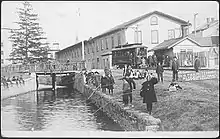
A new streetcar system, the Galt, Preston and Hespeler electric railway (later called the Grand River Railway) began to operate in 1894, initially connecting Preston and Galt. In 1911, the line reached Hespeler, Berlin (later called Kitchener) and Waterloo; by 1916 it had been extended to Brantford/Port Dover.[42][43] The electric rail system ended passenger services in April, 1955.
German heritage
While German-speaking settlers from Pennsylvania were the most numerous until about 1840, a few Germans from Europe began arriving in as 1819, including Fredrick Gaukel, a hotel keeper, being one of the firsts. He would build what later became the Walper House in Berlin. Two streets in present-day Kitchener, Frederick and Gaukel streets, are named after him. Other German-speaking immigrants from Europe arrived in Waterloo County during the 1830s to 1850s, bringing with them their language, religion and cultural traditions. Waterloo County soon became recognized throughout Canada for their Germanic heritage. The German community became industrial and political leaders, and created a German-Canadian society unlike any other found in Canada at the time. They established German public schools and German language churches.
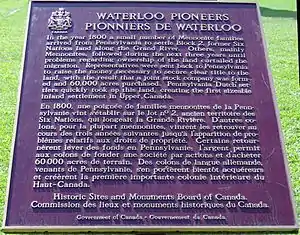
Both the immigrants from Germany and the Mennonites from Pennsylvania spoke German of course, though with different dialects such as Low German or the incorrectly called Pennsylvania Dutch, actually Pennsilfaanisch Deitsch (German).[44] (This dialect is different from Standard German with a simplified grammatical structure, some differences in vocabulary and pronunciation and a greater influence of English.) The combination of various types of German-speaking groups was a notable factor in the history of Waterloo County. The two groups of Germanics were able to understand each other quite easily[45] and there was no apparent conflict between the Germans from Europe and those who came from Pennsylvania.[46]
Some sources estimate that roughly 50,000 Germans directly from Europe settled in a large area of Southern Ontario, in and around Waterloo County, between the 1830s and 1850s.[47] Unlike the predominantly Mennonite settlers from Pennsylvania, the majority of Germans from Europe were of other denominations: most in the first groups were Catholic and those who arrived later were primarily Lutheran.[33]
In 1862, German-speaking groups held The Sängerfest, or "Singer Festival" concert event that attracted an estimated 10,000 people and continued for several years.[48] Eleven years later, the over 2000 Germans in Berlin, Ontario started a new event, Friedenfest, commemorating Prussian victory Franco-Prussian war. This annual celebration continued until the start of WWI.[49] In 1897, they raised funds to erect a large monument, with a bronze bust of Kaiser Wilhelm 1, in Victoria Park. (The monument would be destroyed by townspeople just after the start of WWI.)[7]
By 1871, nearly 55 percent of the population had German origins, including both those of Pennsylvania Mennonite and European Germans. This group greatly outnumbered the Scots (18 per cent), the English (12.6 per cent) and the Irish (8 per cent).[33] Berlin, Ontario was a bilingual town with German being the dominant language spoken. More than one visitor commented on the necessity of speaking German in Berlin.
Immigration from continental Germany slowed by 1880. First and second-generation descendants now comprised most of the local German population, and while they were proud of their German roots, most considered themselves loyal British subjects. The 1911 Census indicates that of the 15,196 residents in Berlin, Ontario, about 70% were identified as ethnic German but only 8.3% had been born in Germany. By the beginning of the First World War in 1914, Berlin and Waterloo County were still considered to be predominantly German by people across Canada. This would prove to have a profound impact on local citizens during the war years. During the first few months of the war, services an activities at Lutheran churches in Waterloo County continued on as they always had. However, as anti-German sentiment increased throughout Waterloo County, many of the churches decided to stop holding services in German.[50]
By the early 1900s, North Waterloo County (the Kitchener, Waterloo and Woolwich Township areas) exhibited a strong German culture and those of German origin made up a third of the population in 1911, with Lutherans as the primary religious group. The Mennonites at that time primarily resided in the rural areas and small communities.[51]
The governor general of Canada, the Duke of Connaught, while visiting Berlin, Ontario, in May 1914, discussed the importance of Canadians of German ethnicity (regardless of their origin) in a speech: "It is of great interest to me that many of the citizens of Berlin are of German descent. I well know the admirable qualities – the thoroughness, the tenacity, and the loyalty of the great Teutonic Race, to which I am so closely related. I am sure that these inherited qualities will go far in the making of good Canadians and loyal citizens of the British Empire".[50]
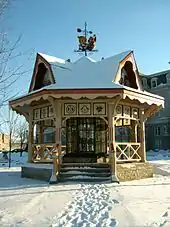
Nonetheless, before and during World War I, there was some Anti-German sentiment in Canada and some cultural sanctions on the community, particularly in Berlin, Ontario. However, by 1919 most of the population of what would become Kitchener, Waterloo and Elmira were "Canadian"; over 95 percent had been born In Ontario.[52] Those of the Mennonite religion were pacifist so they could not enlist and the few who had immigrated from Germany (not born in Canada) could not morally fight against a country that was a significant part of their heritage.[53] [54] The anti-German sentiment was the primary reason for the Berlin to Kitchener name change in 1916. News reports indicate that "A Lutheran minister was pulled out of his house ... he was dragged through the streets. German clubs were ransacked through the course of the war. It was just a really nasty time period.".[55] A document in the Archives of Canada makes the following comment: "Although ludicrous to modern eyes, the whole issue of a name for Berlin highlights the effects that fear, hatred and nationalism can have upon a society in the face of war."[56]
The Waterloo Pioneer Memorial Tower built in 1926 commemorates the settlement by the Pennsylvania 'Dutch' (actually Pennsilfaanisch Deitsch, or German) of the Grand River area of Waterloo County.[57]
This county is still home to the largest population of Old Order Mennonites in Canada, particularly in the areas around St Jacobs and Elmira.[58]
Running for nearly 50 years now, the Kitchener-Waterloo Oktoberfest has been a remembrance of the Region's German Heritage. The event includes beer halls and German entertainment, as well as a major parade, The second largest Oktoberfest in the world, the event is based on the original German Oktoberfest and is billed as Canada's Greatest Bavarian Festival. In recent years, it has been attracting an average of 700,000 people to the county. During the 2016 Oktoberfest parade, an estimated 150,000 people lined the streets along the route.[59]
Successor
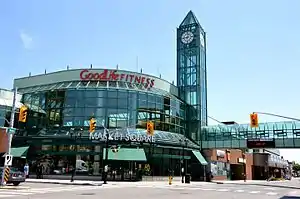
Created in 1853, Waterloo County consisted of five townships: Woolwich, Wellesley, Wilmot, Waterloo, and North Dumfries, including the cities, towns and villages in each area.
The county was dissolved in 1973 and the new Regional Municipality of Waterloo, was formed, consisting of the cities of Kitchener, Cambridge, and Waterloo and the townships of Wellesley, Woolwich, Wilmot, and North Dumfries. In addition, a small portion of Beverley Township, in the former Wentworth County (now City of Hamilton), was added to North Dumfries and the Waterloo Region.
More specifically, the cities of Galt, Kitchener, and Waterloo were previously independent single-tier municipalities prior to joining the newly formed regional municipality. In the 1973 reorganization, the fifteen towns and townships of the county were reduced to just seven in the new Region of Waterloo. The new city of Cambridge was created by the amalgamation of the city of Galt, the towns of Preston and Hespeler, the village of Blair, and various parcels of township land. One township vanished when the former Waterloo Township was divided among Woolwich Township and the three cities of Kitchener, Waterloo, and Cambridge. The community of Bridgeport was annexed to the city of Kitchener. Erbsville was annexed to the city of Waterloo. The former county government was given broader powers as a regional municipality.
The Region of Waterloo, with Jack A. Young as its first chairman, took over many services, including Police, waste management, recreation, planning, roads and social services.[60]
The Region is 1,369 square kilometres in size and its regional seat of government is in Kitchener. The Region's population was 535,154 at the 2016 census.[61][62] The former village, town and city councils joined into the council of a new township or city. An overseeing regional council handles the former county-level responsibilities, as well as now providing police and other service for the Region as a whole.
References
- "The Walter Bean Grand River Trail - Waterloo County: The Beginning". www.walterbeantrail.ca. Retrieved 30 September 2018.
- "Discover". Region of Waterloo. Region of Waterloo. 2015. Retrieved 23 March 2017.
- "History" (PDF). Waterloo Historical Society 1930 Annual Meeting. Waterloo Historical Society. 1930. Retrieved 13 March 2017.
- "Kitchener-Waterloo Ontario History - To Confederation".
- "Waterloo Township". Waterloo Region Museum Research. Region of Waterloo. 2013. Retrieved 13 March 2017.
To correct the situation, a formal agreement was arranged between Brant and Beasley. This arrangement allowed Beasley to sell the bulk of Block Two in order to cover his mortgage obligations completely, while giving the Mennonite buyers legal title to land they had previously purchased. Subsequently, Beasley sold a 60,000 acre tract of land to the German Company of Pennsylvania represented by Daniel Erb and Samuel Bricker in November 1803. Beasley's sale to the German Company not only cleared him of a mortgage debt, but left him with 10,000 acres of Block Two land which he continued to sell into the 1830s.
- "Waterloo Township". Waterloo Region Museum Research. Region of Waterloo. 2013. Retrieved 13 March 2017.
- Cook, Wayne. "Historical Plaques of Waterloo County". www.waynecook.com. Archived from the original on 25 March 2017. Retrieved 25 March 2017.CS1 maint: unfit URL (link)
- "Mennonite cemetery offers glimpse into Kitchener's earliest days". 2016-01-31.
- Good, E. Reginald; Tiessen, Paul (1988). "Schneider, Joseph". Dictionary of Canadian Biography - Volume VII (1836-1850). University of Toronto/Université Laval.
- Seiling, Jonathan (23 June 2012). "Unwilling participants in the War of 1812". The Record. Retrieved 28 March 2017.
- Breithaupt, William Henry (1927). "History of Waterloo County". In Middleton, Jesse Edgar; Landon, Fred (eds.). Province of Ontario – A History 1615 to 1927. Toronto: Dominion Publishing Company. p. 991.
- "Homepage". 2019-08-07.
- "1001 St. Jacobs Waterloo Region, Ontario Canada Information - proudly presented by Kanada News' Canada Vacation Planner the Online Travel Directory".
- Connon, John (1975). The Early History of Elora, Ontario and Vicinity. ISBN 9780889200128.
- "West Woolwich Mennonite Meetinghouse (Elmira, Ontario, Canada) - GAMEO".
- "Elmira Mennonite Meetinghouse (Elmira, Ontario, Canada) - GAMEO".
- http://www.visitor.on.ca/elmira/
- "Old Order Mennonite groups in Ontario are growing". December 2015.
- "About Woolwich". 2018-03-20.
- Lehmann (1986) passim
- "German Canadians". The Canadian Encyclopedia. The Canadian Encyclopedia. 2016. Retrieved 13 March 2017.
- Armstrong, Frederick H. (1985). Handbook of Upper Canadian Chronology. Toronto: Dundurn Press. p. 195. ISBN 0-919670-92-X.
- An Act erecting certain parts of the Counties of Halton and Simcoe into a new District, by the name of the District of Wellington, S.U.C. 1837 (1st Session), c. 116 , implemented by Proclamation of June 18, 1840
- 1837 Act, s. 28
- Smith, Wm. H. (1846). SMITH'S CANADIAN GAZETTEER - STATISTICAL AND GENERAL INFORMATION RESPECTING ALL PARTS OF THE UPPER PROVINCE, OR CANADA WEST. Toronto: H. & W. ROWSELL. pp. 205–206.
- Smith, Wm. H. (1846). SMITH'S CANADIAN GAZETTEER - STATISTICAL AND GENERAL INFORMATION RESPECTING ALL PARTS OF THE UPPER PROVINCE, OR CANADA WEST. Toronto: H. & W. ROWSELL. p. 15.
- An Act to make certain alterations in the Territorial Divisions of Upper Canada, S.Prov.C. 1851, c. 5, Sch. A and B
- "Proclamation". Canada Gazette. 12 (3): 75. 22 January 1853.
- "Flash from the Past: Seven meetings that decided Waterloo County". 2017-07-14.
- "Building a new Waterloo County". 2017-07-08.
- "Homepage". 2019-08-07.
- County of Waterloo Gazetteer and General Business Directory, For 1864 (PDF). Mitchell & Co. 1864.
- Bloomfield, Elizabeth; Foster, Linda; Forgay, Jane (1993). Waterloo County to 1972 : an annotated bibliography of regional history. Waterloo: Waterloo Regional Heritage Foundation. ISBN 9780969693604. Retrieved 25 March 2017.
- Mills, Rych (23 November 2018). "Flash from the Past: Hospitals' history of growth a Cambridge-Galt constant". Record. Retrieved 25 November 2018.
- "Waterloo Region Pre-1914". Waterloo Region WWI. University of Waterloo. 2015. Retrieved 20 March 2017.
- http://stjameselmira.ca/?page_id=31
- Tyler, Tracey (3 January 2009). "When 'poorhouse' wasn't only an expression". Toronto Star. Toronto. Retrieved 13 March 2017.
- Mercer, Greg (12 March 2017). "A virtual museum for the 'poorhouse'". Record. Kitchener. Retrieved 13 March 2017.
- "Waterloo County House of Industry and Refuge". Waterloo House of Refuge. Social Innovation Research Group. March 2017. Retrieved 13 March 2017.
The poorhouse was one of the earliest forms of social welfare available to people without other options for food, shelter, or the care needed for their survival. The poorhouse became the place to send people who were very poor, desperate, distressed, disabled, pregnant without support, old, or ill so that they were outside the view of other citizens.
- "House of Industry and Refuge Cemetery". Find A Grave. Find A Grave. 2016. Retrieved 13 March 2017.
The first starting in 1869 was located north of the railroad tracks which run parallel to Victoria St. It continued in operation until 1884 when a new cemetery was started ... bounded by Dunham Avenue, Mansion Street and Indiana Street.
- Mercer, Greg (25 January 2015). "Searching for Kitchener's lost graveyards". The Record. Retrieved 25 March 2017.
- "CAMBRIDGE AND ITS INFLUENCE ON WATERLOO REGION'S LIGHT RAIL TRANSIT". Waterloo Region. Waterloo Region. 19 January 2017. Retrieved 10 March 2017.
- Mills, Rych (10 January 2017). "Flash From the Past: Preston Car and Coach goes up in smoke". Record. Kitchener. Retrieved 10 March 2017.
- Draper, Barb (12 January 2017). "10 things to know about Mennonites in Canada". Canadian Mennonite. Retrieved 28 March 2017.
- Bloomfield, Elizabeth (October 1997). "Building Community on the Frontier : the Mennonite contribution to shaping the Waterloo settlement to 1861" (PDF). Ontario Mennonite History. 15 (2). Retrieved 28 March 2017.
- "Religion in Waterloo North (Pre 1911)". Waterloo Region. Waterloo Region. 2015. Retrieved 21 March 2017.
- "German Canadians". The Canadian Encyclopedia. The Canadian Encyclopedia. 2016. Retrieved 13 March 2017.
- "Waterloo Region 1911". Waterloo Region WWI. University of Waterloo. 2015. Retrieved 20 March 2017.
- "Friedensfest (1871)". Waterloo Region WWI. University of Waterloo. 2015. Retrieved 20 March 2017.
- "City on Edge: Berlin Becomes Kitchener in 1916" Exhibit at Waterloo Region Museum, on display 2016.
- "Waterloo Region Pre-1914". Waterloo Region WWI. University of Waterloo. 2015. Retrieved 20 March 2017.
- "Waterloo Region 1911". Waterloo Region WWI. University of Waterloo. 2015. Retrieved 20 March 2017.
- "Mennonites and conscription". wartimecanada.ca. Wartime Canada. Retrieved 25 March 2017.
- D'Amato, Louisa (28 June 2014). "First World War ripped away Canada's 'age of innocence'". Kitchener Post, Waterloo Region Record. Kitchener. Retrieved 14 March 2017.
- "Kitchener mayor notes 100th year of name change". CBC News. 1 September 2016. Retrieved 25 March 2017.
- "ARCHIVED - Did You Know That… - ARCHIVED - Canada and the First World War - Library and Archives Canada". 30 June 2016. Archived from the original on 30 June 2016.CS1 maint: bot: original URL status unknown (link)
- "HistoricPlaces.ca - HistoricPlaces.ca".
- https://canadaalive.wordpress.com/2014/03/31/old-order-mennonites/
- Baker, Jennifer K. (16 October 2016). "Oktoberfest 2016 comes to a close". CTV Kitchener. Retrieved 25 March 2017.
- "Get to Know Us During Local Government Week". Waterloo Region. Waterloo Region. 10 October 2012. Retrieved 23 March 2013.
- Outhit, Jeff (8 February 2017). "Waterloo Region growing but not as fast, census shows". Record. Kitchener. Retrieved 13 March 2017.
- [Province of Ontario – A History 1615 to 1927 by Jesse Edgar Middleton & Fred Landon, copyright 1927, Dominion Publishing Company, Toronto]